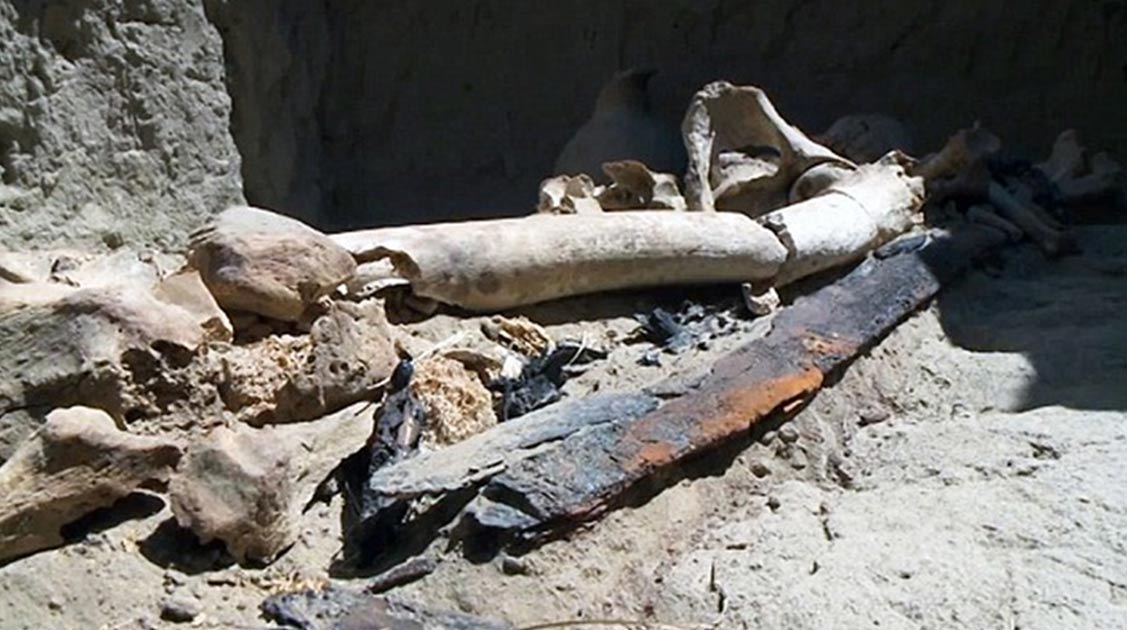Woman buried with weapons is first evidence of female warriors among the Kangyuy people of Kazakhstan
The skeleton of a woman who lived more than 1,600 years ago and who was buried with a sword, a dagger, arrows, and pottery has been unearthed in Kazakhstan. Archaeologists say she was probably a high status person among the Kangyuy people, nomads who lived near the Syr Darya River and the Aral Sea in the southern steppes. The incredible discovery is the first evidence that women of the Kangyuy went to war.
The fact the warrior woman was buried with pots and bowls indicates she was an elite member of society who had some material wealth, says an article in The Telegraph. Researchers said she lived between the 11 th century BC and the 4 th century AD and determined her sex by the shape and size of her skull.
While such grave goods may not seem rich to modern people, worked metal and pottery were among the most important goods a person could own, and to bury them where they could not be of any use to living people indicates the person was important and a highly valued member of the community.
Archaeologists have been doing research and digging in this area of Kazakhstan for 23 years. The woman's remains and her grave goods will be displayed in the National Museum of Kazakhstan.
The Kangyuy people controlled part of the Silk Road and are known for repelling a Hun invasion in the 6 th century AD. The Huns, who are famous mostly from their attacks on the Roman Empire, first came to Europe from Asia in the 4 th century AD. Their tribes were active making war in Central Asia from the 4 th century BC, according to Kazakh.tv. After the Huns were defeated in the Steppes, the Turks ruled there.
- Ancient instrument found in Turkic warrior burial in Kazakhstan
- Reconstruction of Golden Woman, the ancient Scythian Princess of Kazakhstan
- The Eerie Balbal Statues of the Eurasian Steppe

The warrior woman had some large pots and water jars in her grave, indicating some degree of wealth, researchers said. Credit: MailOnline
The most-studied structure of the Kangyuy people is in the settlement of Aktobe near Chardara on the east bank of the Syr Darya River. It is a palace of 28 meters (92 feet) by 18.5 meters (67 feet) with five rooms, an entrance area and two corridors. There was a square hall in the center that measures 3.6 by 3.6 meters. The palace had a flat roof.
While the Kangyuy people were nomads, it appeared they had metalworking and agriculture—two signs of civilization that are not always associated with nomads. As mentioned, they had ceramics and copper pots, frying pans, fireplace supports, water vessels and jugs and bowls. They smelted iron to make knives, sickles, arrow tips and fasteners. Archaeologists have found amulets made of bone, wolf, eagle and dog parts. They have also found jewelry made of gold and bronze. They had beads of carnelian, turquoise and colored glass and stone. They made earrings, bracelets, hairpins.
Archaeologists have found cereal grains in Kangyuy areas. They also found straw in flooring made of plaster and in a brick; straw was used in plastic architectural materials to strengthen them when they dried. The Kangyuy turned the soil with stone mattocks that have been found in settlements. They also used bone agricultural tools. They had irrigation, which was accomplished by damming channels of rivers and bringing water to the fields and kitchen gardens. Cattle breeding apparently was important to the Kangyuy. Researchers have also found many bones of domesticated horses, sheep and goats in ancient settlements.

The Syr Darya River (Photo by Radim Kolarsky/Wikimedia Commons)
Though they had agriculture, it seems hunting and fishing were important to the Kangyuy. Horns of different animals and fish bones and scales that have been found in their settlements attest to this. They used harpoons and other fishing tackle.
According to e.history.kz, in the time frame of the 1 st century AD to the 5 th century AD the Kangyuy were a large, powerful state that played a big role in the Eastern world that included trade.
“Population of this society was engaged in agriculture and cattle breeding, handicraft and trade. Kangyuy state was politically, economically and culturally connected with China, Parfia, Rome and Kushan empire,” the site says.
Featured image: The bones and the sword in the grave of the first known warrior woman of the ancient Kangyuy people of the steppes of Kazakhstan. Credit: MailOnline
By Mark Miller




















Comments
"Researchers said she lived between the 11th century BC and the 4th century AD" (quite a spread!) while; "According to e.history.kz, in the time frame of the 1st century AD to the 5th century AD the Kangyuy were a large, powerful state." An Amazon perhaps? The pre-Kangyuy population of Kazakhstan were known to be Scythians, who were often connected with the legendary female warriors.